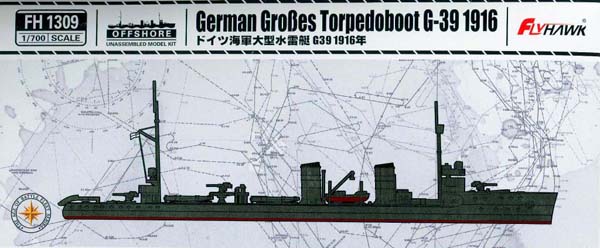1/700 German Großes Torpedoboot G-39 1916


|
by Martin J Quinn |
| HISTORY | |||||||
|
The German Großes
Torpedoboot (large torpedo boat) G-39 was part of a larger class
of German torpedo boats, known collectively as the V-25, or 1913
Type, class of large torpedo boats. Since G-39 was built by
Germaniawerft in Kiel, the "G" in G-39 refers to the shipyard at
which she was constructed.
G-39 was launched
in January 1915, commissioning in August of the same year.
As part of the German battle fleet that participated in the Battle of Jutland
in May, 1916,
G-39 is best know for transferring Admiral Franz von
Hipper from the mortally wounded battlecruiser Lützow to the
battlecruiser Moltke.
According to Tobias Philbin, in Admiral
von Hipper: Inconvenient Hero, Hipper remarked that: "I
had to find myself another flagship because I could no longer exercise
command from one which was shot to pieces...A torpedo boat was called alongside
and we changed under heavy fire...[I] drove my torpedoboat hoping to find
an advantageous moment to board one of [the other battlecruisers]. These
1½ hours that I spent in a hail of shell and splinters aboard the
torpedoboat I shall not be likely to forget."
Post-armistice, G-39 was interned at Scapa Flow, where she scuttled
herself, with other elements of the once proud Kaiserliche Marine, on June
21, 1919. The wreck was raised and scrapped in 1925. For more on G-39, visit her Wikipedia page here, which is where this abridged history was pulled from. |
|||||||
| The
Flyhawk Großes Torpedoboot G-39
Flyhawk’s 1/700 SMS G-39 comes in a small cardboard box with a rendering of the ship on the box top. The instructions are on the back, with color callouts on the side panel. |
|||||||
|
|||||||
| THE HULL |
|
||||||
| The hull is waterline only, with separate
upper hull, main deck and waterline plate. The hull appears to scale
out to the correct length and beam.
There is the detail we've all come to expect from Flyhawk: nice portholes, with faint raised eyebrows; some raised lines along the hull, to replicate hull plating, bollards molded integral to the hull and other finely molded details on the fo'c'sle, including a breakwater, hatches and anchor gear. The "plating" lines on the hull are most like over scale, but under a coat of paint, they'll probably look fine. |
|||||||
|
|||||||
| DECK AND WATERLINE PLATE | |||||||
| The deck also has nice detail, with skylights, what look like coal scuttles, hatches and a finely molded track along the starboard side, which I presume is either for torpedoes or mines. The skylights are particularly well done. The waterline plate is a waterline plate. What else needs to be said? | |||||||
|
|||||||
| SPRUE A | |||||||
| There is just one sprue, consisting of about 39 parts, included with the kit. Considering how small this vessel is, that's not surprising. What else is also not surprising? The level of detail. The searchlights have shutter detail molded on, the funnels molded on hand rails, the davits are petit, the main battery is nicely molded, the cowl vents have recessed openings, while the torpedo tubes are especially well molded. The only "negative" is the main mast on my sample is slightly bent. If you are planning to rig your model, you may want to replace the masts with brass rod anyway. |  |
||||||
|
|||||||
| DECALS | |||||||
| There is one small decal sheet included with the kit, consisting of different styles (straight and "fluttering") and sizes of theKaiserliche Marine ensign. | |||||||
|
|||||||
| INSTRUCTIONS | |||||||
| The instructions are on the back of the box. They are simple, but easy to follow. The painting instructions - which reference Colourcoats paint numbers only - are on the side of the box. This scheme is supposed to represent G39 during the Battle of Jutland in May, 1916, though some sources say the torpedobootes were painted overall light gray/white by this time. Check your references before painting. | |||||||
|
|||||||
| CONCLUSIONS | |||||||
| It seems that Flyhawk has done it
again - this is a really nice little kit. I have no particular
references for this class of ships, but scouring photos on the internet,
the model certainly "looks" the part.
If you need to screen your scale Kaiserliche Marine scouting force battlecruisers, G-39is the escort that you are looking for. With less than 45 parts, it shouldn't take long to put together, even if you purchase the separate photo-etch set. This is Flyhawk’s 1/700 German Großes Torpedoboot G-39 1916, kit number FH1309. The kit retails for $12.50, and should be available from many of our fine sponsors. There is no photo-etch or deck masks included with this basis version, but those are available separately. Thanks to Flyhawk for the review sample. Recommended. This is an in box review, your mileage may vary once you start assembly. |
 |
||||||
| This is an in-box review showing the kit contents. We welcome your input and comments in the review section of the forum. Click the logo on the right to join in the discussion. |  |
